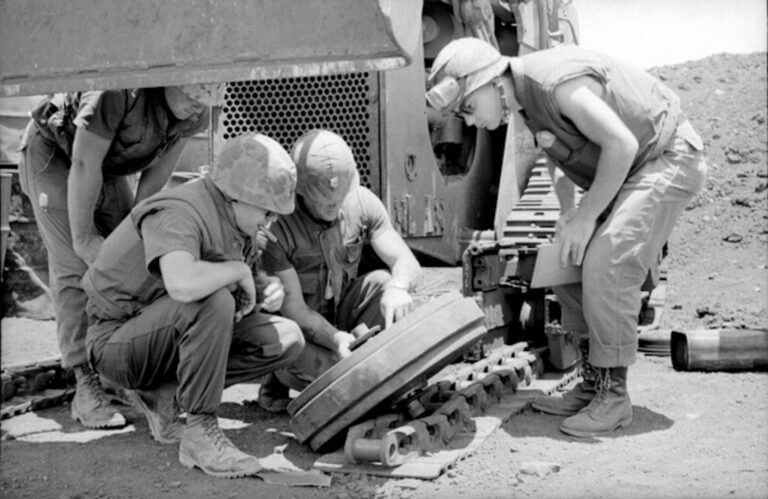Consolidated by the US Navy Seabee Museum, Naval History and Heritage Command
August 9
1946: 20th Naval Construction Regiment (RCN) inactivated.
1967: NMCB vehicle 1 struck by a Claymore mine on Route 1. One man was killed in action and five men were injured.
1968: Cmdr. Warren H. Anderson, CEC, relieved Cmdr. Richard D. Coughlin, CEC, as commanding officer of NMCB 71, at Chu Lai, Republic of Vietnam (RVN).
2002: First Naval Construction Division (1NCD) commissioned at Naval Air Station (NAB), Little Creek, Virginia, under the command of Rear Admiral Charles Kubic. The Division made Naval Construction Forces Atlantic and Pacific a unified Seabee command for worldwide operations.
2002: Captain Gary Engle was selected as the first chief of staff of the newly created 1NCD, tasked with leading the Naval Construction Force (NCF) globally.
August 10
1943: ACORN 11 arrived in Nouméa. (Used during World War II, an ACORN was a tailor-made unit designed to carry out the rapid construction and subsequent operation of a forward base of landplanes and seaplanes. Each ACORN was staffed with a construction battalion , as well as trained personnel to operate the control tower, field lighting, aerological unit, transportation, medical, mooring and catering facilities. A Construction Battalion Maintenance Unit (CBMU) also accompanied each ACORN to maintain the base after initial construction was completed and the construction battalion withdrew. During the war, ACORNs were sent to such locations as Guadalcanal, Espiritu Santo, Green Island, Rendova, Treasury Island, and Majuro .)
August 11
1942: The Naval Construction Training Center (NCTC), Davisville, Rhode Island, is commissioned. 18th NCB commissioned at Camp Allen, Norfolk, Virginia.
1944: 8th AON commissioned.
1953: A devastating earthquake on the Greek island of Kefalonia resulted in a demonstration of Seabee-Marine teamwork. The commander of the U.S. 6th Fleet ordered 11 Marines and two Seabees from ACB 2 to form a landing party to assist the Greeks in emergency relief operations. The two Seabees were George F. Dyer and Robert J. Gillie. With equipment brought from their ships ashore, the Seabees and Marines first cleared a road from the beach to the village so the Jeeps could evacuate the wounded. A large landslide that completely blocked the road had to be destroyed before Seabee bulldozers could begin clearing a path.
1967: Seabee Team 0407 moved from Saigon to Can Tho, RVN.
1968: Seabee Team 0310 with 12 men arrived in Long Kuyen, RVN, while Seabee Team 0311 with 12 men arrived in Can Tho, RVN.
1970: Captain JF Washurn, CEC, was relieved by Captain KP Sears, CEC, as commander of the 32nd NCR.
August 12
1942: The 11th NCB was the first battalion to leave Forward Base Depot, Port Hueneme, California, by boat. The battalion sailed on the SS Japara for Tutuila, Samoa.
1942: The 18th NCB arrived at NCTC Davisville, Rhode Island, for advanced training. It was the first battalion to do so.
1943: 110th NCB commissioned at NCTC Camp Peary, Magruder, Virginia.
1944: 38th RNC commissioned.
1966: NMCB 133 ordered, CBC, Gulfport, Mississippi.
August 13
1943: 101st NCB commissioned at NCTC Camp Peary, Magruder, Virginia. 115th NCB trained at NCTC Camp Peary, Magruder, Virginia.
1968: The main body of NMCB 58 arrived at Davisville, Rhode Island, from Da Nang, RVN.
1968: Seabee Teams 0703 and 0704 arrived in Da Nang, RVN, and headed directly to the towns of Soc Trang and Go Cong, respectively.
1968: Cmdr. JC Rickels, CEC, relieves Cmdr. LD Lawson, CEC, as commander of NMCB 7.
1968: Cmdr. RL Dunlap, CEC, commanding officer of NMCB 22, relieved Cmdr. CJ Mathews, CEC, commanding officer of NMCB 58, as commanding officer of Camp Haskins, North Da Nang, RVN.
1968: Captain AW Walton Jr., CEC, relieved Captain JM Hill Jr., CEC, as commander of the 32nd RNC.
1968: The first two flights of the main body of NMCB 58 departed Camp Haskins North, RVN, returning to CBC, Davisville, Rhode Island.
August 14
1970: Cmdr. HE Keppel Jr., Civil Engineer Corps (CEC), relieved Lt. Cmdr. HH Harrell, CEC, as Commander, Construction Battalion Maintenance Unit (CBMU) 302, at Naval Support Facility (NSF), Cam Ranh Bay, Republic of Vietnam (RVN).
August 15th
1942: 19th Naval Construction Brigade (NCB) established at Camp Bradford, Norfolk, Virginia.
1944: Invading forces landed on Guam, Mariana Islands, on July 21. The initial objective was to take possession of the port of Apra, as well as the surrounding development zone and the airfield on the Orote Peninsula. Landing forces struck north and south of the port. The Seabees participated in the assaults: the 25th and 2nd Special NCB on the beaches north of the port, and the 53rd and 13th Special NCB, and CBMU 515 on the southern beaches. For three weeks, fighting and construction continued until finally, on August 10, Japanese resistance ended. With considerable development planned for Guam, the 5thth The Naval Construction Brigade was created. The brigade took control of the construction and development of base facilities for the Army and Navy. Guam has become a major military air base, as well as the main naval base in the Western Pacific.
1944: 120th BCN inactivated at Davisville, Rhode Island.
(1945:38th Special BCN inactivated at Advance Base Depot (ABD), Port Hueneme, California.
1951: Naval Mobile Construction Battalion (NMCB) 7 established at the Construction Battalion Center (CBC) Davisville, Rhode Island.
1971: Construction Battalion (CBU) Unit 417 established at Naval Air Station (NAS), Whidbey Island, Washington.
–>

